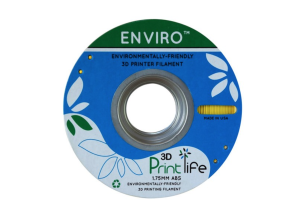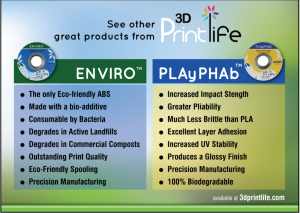 There is a duality in desktop 3D printing: if you want to have an eco-friendly material you need to use PLA, which is fragile and brittle. If you want to use ABS you have to consider that it is derived from hydrocarbons and thus not so good for the planet. Los Angeles-based 3D Printlife has carved out a niche for itself in the desktop 3D printing market by offering both functional and eco-friendly ABS and PLA solutions
There is a duality in desktop 3D printing: if you want to have an eco-friendly material you need to use PLA, which is fragile and brittle. If you want to use ABS you have to consider that it is derived from hydrocarbons and thus not so good for the planet. Los Angeles-based 3D Printlife has carved out a niche for itself in the desktop 3D printing market by offering both functional and eco-friendly ABS and PLA solutions
Apparently the solution proposed by 3D Printlife is perfectly suited for desktop 3D printing’s mass market ambitions, as several of the largest online big box stores are already offering 3D Printlife products, with Walmart (May) and Target (mid-June) soon joining a growing list of vendors.
PLAying with the Big Boxes
 Online giants such as Amazon and Best Buy already carry both products on their sites, and many other mainstream manufacturers have turned to 3D Printlife for their supply chain. The LA company’s two main product lines are the ENVIRO ABS, which is the currently the world’s only eco-friendly ABS filament, and PLAyPHAb, a polyester enhanced PLA filament.
Online giants such as Amazon and Best Buy already carry both products on their sites, and many other mainstream manufacturers have turned to 3D Printlife for their supply chain. The LA company’s two main product lines are the ENVIRO ABS, which is the currently the world’s only eco-friendly ABS filament, and PLAyPHAb, a polyester enhanced PLA filament.
ENVIRO is 100% pure ABS, made in the USA. The difference from other non-biodegradable ABS filament is that it is extruded with a bio-additive that allows the filament to break down to CO2 and methane in an energy re-capture landfill setting. This breakthrough filament has set the standard in “green” 3D printing when using ABS filament. 3D Printlife did not stop its eco-friendly forward thinking at just the filament either.
Back to the Earth
 Packaged in a colorful spool made of 100% recycled cardboard with a tin flange that is also recyclable, ENVIRO is shipped with a wildflower seed insert that when planted grows perennial and annual wildflowers. The company even donates a $1 from the sale of every spool sold to plant a tree.
Packaged in a colorful spool made of 100% recycled cardboard with a tin flange that is also recyclable, ENVIRO is shipped with a wildflower seed insert that when planted grows perennial and annual wildflowers. The company even donates a $1 from the sale of every spool sold to plant a tree.
PLAyPHAb starts from PLA and enhances its polyester in order to provide the superior strength and durability of ABS. Although the exact blend may differ, this approach is not as entirely unique (colorFabb also uses PHA in some of its PLA): it is essential in strengthening the PLA while still allowing for the biodegradability of PLA. PLAyPHAb is also packaged in the same colorful 100% recycled cardboard spool allowing for zero carbon footprints.
3D Printlife’s claim, “Feel great about your prints. Feel great about your world,” apparently struck a chord with many users and, perhaps even more importantly, with retailers that will be strategic in 3D printing adoption by the larger public. Sure, it is still mostly a matter of long tail, for now, but it is already paying off. Perhaps the use of environmentally friendly filament will never have a huge impact on global CO2 emissions, but desktop 3D printing is just at the beginning of its evolution and it is better to pick up good habit from the start.
Subscribe to Our Email Newsletter
Stay up-to-date on all the latest news from the 3D printing industry and receive information and offers from third party vendors.
You May Also Like
Precision at the Microscale: UK Researchers Advance Medical Devices with BMF’s 3D Printing Tech
University of Nottingham researchers are using Boston Micro Fabrication‘s (BMF) 3D printing technology to develop medical devices that improve compatibility with human tissue. Funded by a UK grant, this project...
3D Printing Webinar and Event Roundup: April 21, 2024
It’s another busy week of webinars and events, starting with Hannover Messe in Germany and continuing with Metalcasting Congress, Chinaplas, TechBlick’s Innovation Festival, and more. Stratasys continues its advanced training...
3D Printing Webinar and Event Roundup: March 17, 2024
It’s another busy week of webinars and events, including SALMED 2024 and AM Forum in Berlin. Stratasys continues its in-person training and is offering two webinars, ASTM is holding a...
3D Printed Micro Antenna is 15% Smaller and 6X Lighter
Horizon Microtechnologies has achieved success in creating a high-frequency D-Band horn antenna through micro 3D printing. However, this achievement did not rely solely on 3D printing; it involved a combination...





























